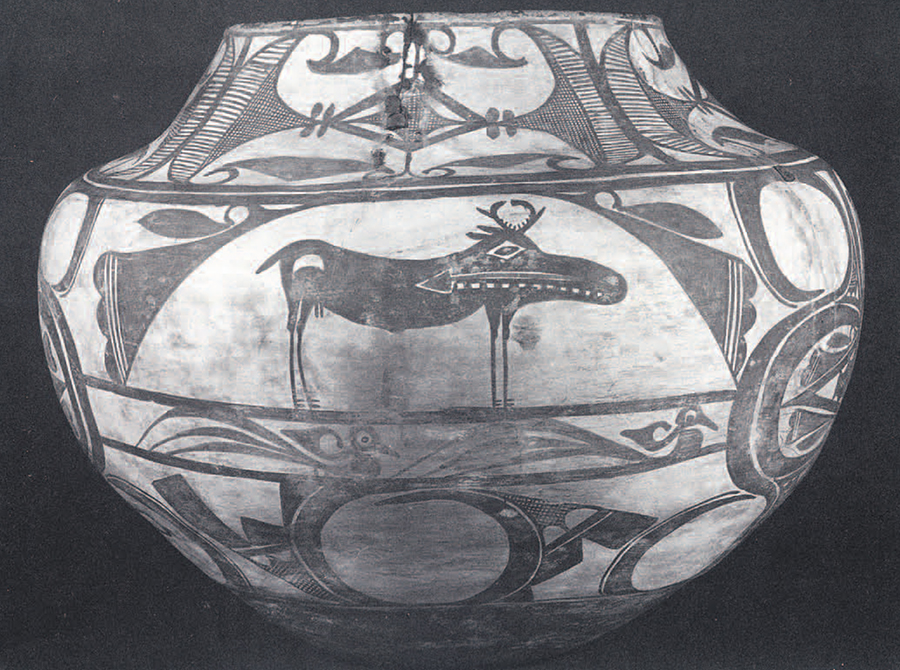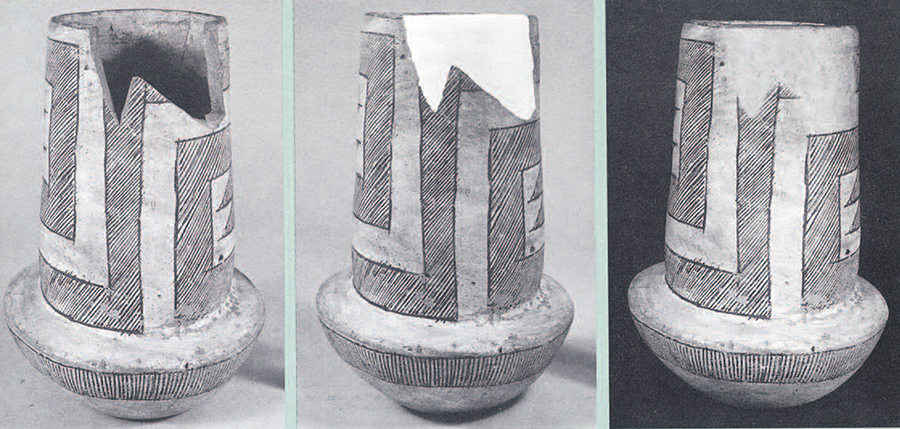Southwest Pottery Artifacts on Tour: A Report from Conservation

The University Museum has had an active program of loaning artifacts to other public institutions since its earliest days and over the past few years has been developing a program of traveling exhibits from the Museum’s collections. The Conservation Department’s involvement in loans and traveling exhibits has evolved to the point where one of the two conservators on staff works almost full time on material being exhibited outside the Museum. Beauty from the Earth was the Museum’s first show planned as a traveling exhibit from its inception. In preparation for Beauty from the Earth’s journey around the country, Conservator Lynn Grant examined and treated more than 100 rarely exhibited pots from the Museum’s Southwest collections. Here she takes us into the Conservation Laboratory for a firsthand account of the process, from cleaning to crating.
Traveling exhibits, by their very nature, expose artifacts to more potential hazards than any other phase of their museum existence. An object that will be traveling to a series of other institutions is subjected to more stresses, from transit and increased handling, than one which remains in storage or is only displayed in the home museum. However, with careful planning and attention to detail, the real risk is minimal and is greatly outweighed by the advantages of making the collections known to a wider audience.
Conservators prefer to follow a policy of “minimum intervention” in treating artifacts—doing no more to an object than is absolutely necessary to stabilize it. For an exhibit that is scheduled to travel to eight venues over a three-year period, however, the minimum treatment necessary for stabilization must be redefined and a higher level of conservation treatment applied.
The conservator’s involvement with any exhibit starts after the curatorial selection of artifacts. All must be examined to see whether they are sufficiently stable to be displayed as proposed, or can be made so by conservation treatment. In the case of Beauty from the Earth, the fact that the exhibit would travel to a number of venues had to be taken into account. Only one of the southwestern pots selected for the show posed a serious problem: a Zuni polychrome olla that had split during firing or use during the late 19th century and been repaired with pine pitch (Fig. 1). Such native repairs are an integral part of an ethnographic object and must be preserved wherever possible. The olla could not be stabilized sufficiently to travel with the show without damaging the native repair. In consultation with the curator of the exhibit and the Keeper of the American Section, the decision was made to display the olla with the show here at the Museum, but to replace it with a similar piece for the other venues.
Documentation and Cleaning

Treatment began with a careful examination and documentation of each artifact in the show. Most of the ceramics in Beauty from the Earth had been in storage in the Museum since they were collected, in many cases since the turn of the century. The Museum’s storage program now emphasizes keeping the collections covered in clean storage areas, but the southwestern pottery had suffered many decades of less enlightened practices and had a corresponding accumulation of dust and soot. In some cases this dirt layer obscured the designs. Cleaning the pottery took on some of the excitement of an archaeological excavation, as bright and beautiful designs emerged from the grime (Fig. 2). The carbon paint used to create the designs on some of the pottery was quite delicate and great care had to be taken to avoid damaging it during the necessary cleaning. On some vessels documentation written directly on the ceramic surface was only visible after cleaning; some writing was so faint, especially several notes written in sepia ink on Zuni ceremonial vessels, that examination under ultraviolet light was needed to decipher the words. All such documentation was carefully recorded before treatment. As an integral part of the cleaning all the pots were tested for the presence of soluble salts. Such salts result from burial in the earth or from use and, unless removed, may cause eventual disintegration of the pottery. If salt contamination was found, the pots were soaked in deionized water to remove it. During soaking a number of the vessels, particularly the Zuni dough bowls, exuded a greasy substance, probably residues from food preparation. Such evidence of use was carefully recorded so that analysis could be carried out at a later date.
Repair

Nowadays, conservators take great care to use adhesives that remain stable over long periods of time, that do not exert stress on the ceramic material, and that can be removed at any time. Some of the vessels in Beauty from the Earth had been mended before such adhesives were available, or were badly mended. These were taken apart and remended using an acrylic adhesive custom-made in the Conservation Laboratory.
Where necessary, missing areas in the vessels were filled with plaster of Paris. With archaeological ceramics, filling in missing areas is normally done only for structural reasons or to make the original appearance of the vessel more comprehensible to the viewer. This standard was adhered to in treating these ceramics, although the stresses the pottery would be exposed to during the course of the traveling exhibit meant that more ‘structural’ fills were necessary. All the plaster fills were then painted. The conservator does not attempt to match the appearance of the original ceramic exactly hut only to minimize the visual impact on the viewer. The ethic is that the fills should blend in when viewed from a distance but be reasonably obvious on close examination (Fig. 3).
Consolidation
Many of the pots in Beauty from the Earth had nearly invisible hairline cracks, generally running down from the rim or from chipped or broken areas. Such cracks would not normally require treatment, but the stresses of traveling might cause them to increase or even become complete breaks. All these cracks were consolidated with an adhesive and carefully documented so that any changes could be detected.
In the course of treating all those hairline cracks, it was noticed that many otherwise intact vessels had small semicircular chips out of their rims. This phenomenon was explained by the curator, who said that in earlier times, in order to study the interior clay body of intact ceramics, scholars would pinch off a piece of the rim with pliers. The bonfire firing method used by the Pueblo Indians produced relatively brittle and sometimes unevenly fired ceramics prone to cracking, and this rather brutal sampling technique had resulted in the abundance of hairline cracks.
Surface flaking was a problem for a small number of pots in the show. Flaking of surface slip, resulting from a clay slip reacting differently to firing than the clay body, was relatively rare among the Pueblo pottery. In the case of the Sikyatki pottery, surface spalling—loss of saucer-shaped flakes of the clay surface—resulted from expansion of mineral inclusions characteristic to this style of pottery. In either case, the surface was consolidated, either locally or by immersion, with a stable acrylic resin.
Preservative Conservation
There is little point in stabilizing artifacts through conservation treatment if they are later subjected to conditions that will destroy that stability. This is where passive conservation comes into play: controlling the artifacts’ environment to preserve their stability. In the Museum the conservator advises on how objects are stored, displayed, and handled. With traveling exhibits the same parameters apply, with the additional considerations of transporting the material from venue to venue.
The conservator works closely with the exhibits staff, the Assistant Registrar for Traveling Exhibits, and the packers to provide the best possible conditions for the artifacts. Careful consideration is given to making the exhibit package as convenient and uncomplicated as possible for the client museums. The easier the exhibit is to install and dismount, the less stress will be placed on the artifacts (and everyone involved). The packing of the pottery is critical to the success of the traveling exhibit. The crate designs for Beauty from the Earth were fully developed 6 months before the exhibit went on display at the Museum and 16 months before packing would begin. In addition to providing protection from all phases of transit, the packing is designed to promote minimal and proper handling of the artifacts; to resist the wear-and-tear of three years’ use; and to avoid use of packing materials that could cause damage to the pottery.
Such attention to detail is critical to the ultimate success of a traveling exhibit. Beauty from the Earth was the product of a team of Museum staff all dedicated to the best possible presentation of this wonderful material. Conservation was only one small part of the overall effort.
